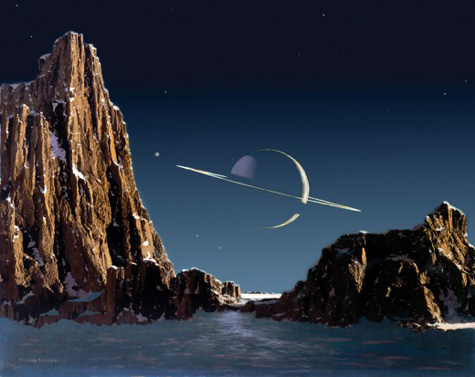Just about everyone doing the kind of space art I do (sometimes referred to as “rock and ball” space art), owes something to Chesley Bonestell. While not the first artist to specialize in astronomical art, he raised to the level of fine art.
A classically trained painter, Bonestell began his career as an architect and architectural renderer. During this time, he contributed to the design of such American icons as the Golden Gate Bridge and the Chrysler Building. He took his painting skills and the knowledge of perspective, light and shadow to Hollywood where he entered the second phase of his long career, creating special effects matte paintings. He worked on such classic films as The Hunchback of Notre Dame and Citizen Kane. All the scenes showing the cathedral and medieval Paris in the former are Bonestell’s artwork as are the scenes of 19th century New York and Kane’s Xanadu.
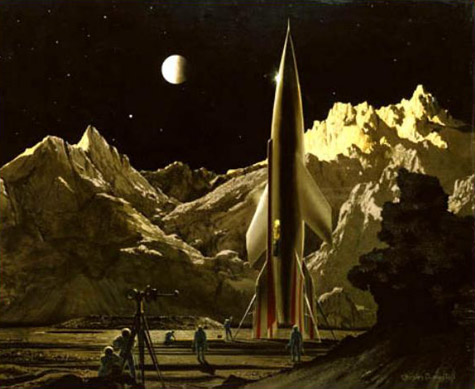
Always deeply interested in astronomy, Bonestell began creating space scenes for his own amusement. After showing a series depicting Saturn as seen from its moons to the editors of Life Magazine, Bonestell’s space art appeared in print for the first time in 1944. After several similar pictorials in Life and other magazines, Bonestell was lured back into motion pictures by George Pal. Bonestell created the fabulous 360-degree panorama of the lunar surface for Destination Moon, the opening sequence for War of the Worlds and the matte paintings for When Worlds Collide. About this same time, Bonestell was invited by Collier’s magazine editor Cornelius Ryan to participate in what was to eventually become known as the “Collier’s Space Program.”
Overseen by Wernher von Braun, a series of half a dozen illustrated magazine articles (which were later collected into book form) outlined a comprehensive plan for the exploration of space. Beginning in 1952 with an issue devoted to the first satellites, the series described the first manned orbital flights, the construction of a space station, the first landings on the moon and ended with an expedition to Mars. Joined by illustrators Rolf Klep and Fred Freeman, Bonestell’s hyper-realistic depiction of space exploration made the prospect of traveling into space seem for the first time like a real possibility. Indeed, the series is credited by many space historians at creating badly needed support at a critical moment in the embryonic American space program.
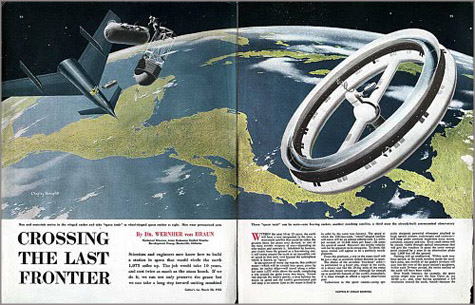
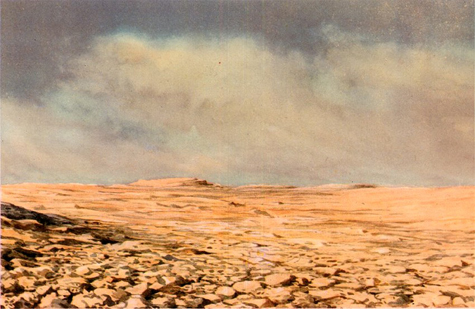
While Bonestell may have been the father of astronomical art, Lucien Rudaux was certainly the grandfather. A commercial artist-turned-astronomer, Rudaux was the first to specialize in astronomical illustration. Born in 1874, he eventually became one of the best observers of his day, working from his private observatory in Donville, France. He combined the results of direct observation with his skills as an artist to create some of the most scientifically accurate space paintings of his day. Indeed, many of his depictions of the moon, Mars and the satellites of Saturn could just as easily have been done today. Where most artists—including Chesley Bonestell—depicted the surface of the moon as being craggy and precipitous, Rudaux’s moon looked more like that seen in Apollo photos: a landscape of gently sloping, rolling hills that resembles South Dakota more than the Alps. He depicted Mars with a pinkish sky (there is a crater on Mars named after Rudaux) and Venus as a hellish dust bowl. He was the author and illustrator of a great many magazine articles and popular books. His classic is the sought-after Sur les autres Mondes (1937), which is filled with black-and-white and color reproductions of scores of his spectacular paintings. My copy of this book was once in Bonestell’s personal library and is now a treasured part of my own space art book collection.
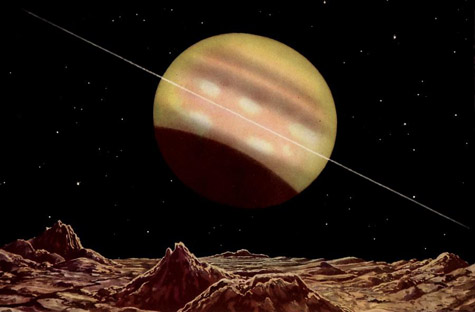
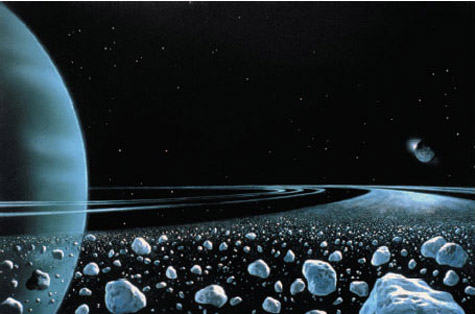
Ludek Pesek (1919-1999) was certainly the most influential astronomical artist to follow Chesley Bonestell. Although very well known in Europe, he was almost unheard-of in the United States until National Geographic commissioned him to illustrate a special article on the planets for its August 1970 issue. Fourteen spectacular paintings took readers on a visual tour of the solar system unlike any published since Bonestell’s Life Magazine appearance in 1944.
Born in Czechoslovakia, Pesek had been inspired by the work of French space artist Lucien Rudaux. His first collections of astronomical paintings were published in the books The Moon and Planets (1963) and Our Planet Earth (1967)… both now highly sought-after. It was these works that caught the attention of National Geographic.
It was there that I first saw Pesek’s work and it completely floored me. I’d been a fan of Chesley Bonestell’s work since I was a kid, but it had never inspired me to try my own hand at doing space art largely because of the perfection of Bonestell’s art. It simply never occurred to that it would even be possible to try to emulate paintings like those. In fact, I didn’t even regard them as paintings… they were more like picture postcards from the future.
But Pesek! Here was a space artist who wasn’t afraid to let the painting show. This actually added to their realism. Where Bonestell’s extraterrestrial landscapes had a park-like perfection to them that was almost surreal, Pesek’s astronomical scenes looked for all the world as though they had been painted from life. There was a naturalism to them that Bonestell’s work didn’t have. Better yet, they weren’t the least bit intimidating. It was after first seeing his paintings in National Geographic that I first wondered if I could try creating astronomical landscapes myself.
I collected everything I could of Pesek’s work—including several of his originals. He eventually authored nearly a dozen books, most of them about astronomy and space travel. I had the immense pleasure of meeting him and his wife, Beatrice, twice, once at his home in Switzerland. He was a charming man, as modest about his work as he was passionate. Sadly, he could find little interest in his space art in Europe and spent his last years creating scenes of his adopted Switzerland and haunting surrealistic pieces, often with an astronomical theme.
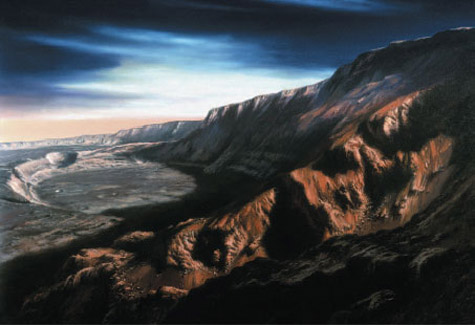
Ron Miller is an illustrator specializing in astronimical art. He contributed over 100 paintings for Scientific America/FSG’s recently released iPad app, Journey to the Exoplanets.










